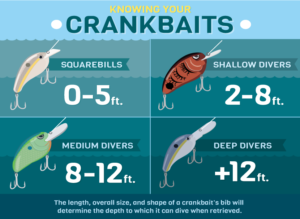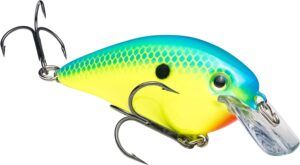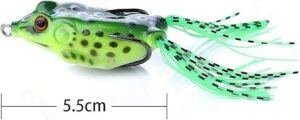Swim Bait Vs The Crankbait, Which Is Better And When?
I’m here to guide you through the incredible world of fishing lures, particularly focusing on the swim bait and crankbait. We’re not just talking about any old tools for catching fish; we’re looking into two dynamic lures that have transformed the way anglers approach the water.
So, swim baits and crankbaits — what are they? These are two popular types of lures that have distinct uses and capabilities. Swim baits mimic the swimming action of prey, often pulling in the big fish, while crankbaits are designed to dive deep and rattle, attracting attention with their noisy profile.
Choosing the right lure isn’t about relying on luck; it’s a blend of skill, knowledge, and understanding the watery world below. That’s going to include knowing the behavior of your target species, the environment you’re fishing in, and how these lures can work for you. Ready to get the lowdown on these lures? Follow along as we jump into the specifics of swim baits and set the stage for a deeper dive into their versatility in the water.
Swim baits are a game-changer for many anglers due to their lifelike appearance and motion in the water. These lures mimic the swimming action of real fish, making them irresistible to predatory species. The versatility of swim baits comes from their variety in sizes, colors, and materials, allowing them to target a wide range of fish under different conditions.
The Crankbait Advantage: Going for the Depths
Crankbaits are renowned for their exceptional ability to target fish in deeper water. Unlike swim baits, these lures are especially designed to dive down and reach areas where certain species tend to hide. Now, let’s break down the details on these depth-charging marvels.
Crankbaits come in a variety of shapes, sizes, and running depths,  from shallow divers that skim just below the surface to deep divers that can reach down more than 20 feet. I’m here to help you understand which of these types will work best for the fish you’re aiming to catch.
from shallow divers that skim just below the surface to deep divers that can reach down more than 20 feet. I’m here to help you understand which of these types will work best for the fish you’re aiming to catch.
One thing that’s central to these lures is their bill shape — it’s what allows them to dive deep. The larger and longer the bill, the deeper the crankbait can go. It’s not just about the bill, though. The body shape, buoyancy, and even the retrieve speed play a huge role in how these lures move through the water.
When it comes to environments perfect for crankbaits, think about places with lots of structure — submerged logs, steep drop-offs, rock piles, and the like. These are the areas where fish often hide out, and the aggressive action and vivid vibrations of a crankbait are just irresistible to them.
There’s a lot of opportunity in using crankbaits for species such as bass, pike, and walleye. I’ve had great success with a slow retrieve during colder months when fish are more lethargic and a faster, more erratic retrieve when the water warms up and fish are actively feeding.
What’s great about crankbaits is their plug-and-play nature. After a cast, the lure does most of the work, with the water resistance against the bill causing it to dive. However, a well-timed pause or twitch can be the key to triggering a strike, especially when fish are following the lure but not biting.
In my opinion, mastery of crankbait fishing involves dedication and a good understanding of the subsurface landscape. Knowing where to cast and how to maneuver your lure around underwater obstacles will drastically increase your chances of a successful catch. You’re going to find out next how knowing the ins and outs of each lure type is crucial for your fishing strategy.
Head-to-Head Comparison: Swim Bait vs Crankbait
When you’re trying to decide between a swim bait and a crankbait, it’s like choosing the right tool for the job. It’s not just about having a preference; it’s also about what will give you the best chance of success in your specific fishing conditions. Let’s look at how these two popular lures stack up against each other.
First off, let’s talk maneuverability. Swim baits, with their lifelike swimming action, can be irresistible to predatory fish. They are designed to mimic the movement of real fish, making them incredibly effective in clear water where fish rely more on sight. On the other hand, crankbaits with their built-in action can be the better choice in murkier waters or when fish are less active, as their vibration and noise can trigger strikes from fish relying more on their lateral line senses.
Versatility is another major factor. While swim baits can be used at various depths depending on their design and how you weight them, crankbaits are usually classified by their diving depth. This comes down to the bill’s shape and size on the crankbait, which causes the lure to dive when retrieved, and allows you to target fish at specific depths.
When discussing depth range, crankbaits generally have an advantage. With models designed to dive shallow, medium, or deep, you can select a crankbait that will get down to where the fish are holding. Swim baits might require extra gear, like weighted hooks or jigheads, to reach comparable depths.
Environmental adaptation is crucial in deciding which lure to use. The swim bait shines in environments with heavy cover, such as weeds or submerged structures, because they are generally weedless and can be swum above or through such obstacles with less chance of snagging. On the flip side, crankbaits often excel in rocky or steeper structured areas where you need a bouncing lure that can deflect off objects and entice fish.
Each type of lure also has pros and cons based on the species of fish you’re targeting. Swim baits are often the choice for anglers going after larger predatory fish like bass, pike, or musky, because of their size and realistic swim patterns. But you shouldn’t discount crankbaits, as certain designs are phenomenal at catching an array of species including bass, walleye, and even some saltwater species, depending on where you fish.
Your experience as an angler can play a role in which lure to pick. If you’re a beginner, you might find crankbaits easier to use, as they require less technique to get the right action. For more experienced anglers who enjoy a more hands-on approach to lure manipulation, swim baits offer the opportunity to add a personal touch to the retrieval pattern.
Making the Right Choice: Factors to Consider
In the end, choosing between a swim bait and a crankbait isn’t about finding a one-size-fits-all answer. It’s about understanding which conditions call for which lure. You’re going to find out about the nuanced factors that should influence your decision.
Water conditions can make or break your fishing success. Sheer clarity or murkiness, currents, and the presence of vegetation are critical variables. Opt for swim baits in clear water where the lifelike appearance and motion can really shine. Conversely, crankbaits can be the ticket in stained or choppy water, as their vibration and noise-making capabilities excel in attracting fish when visibility is low.
Seasonal shifts play a big part in lure selection, too. Fish behavior changes with the seasons, and so should your tackle box. Spring might call for a more subtle approach with swim baits as fish are slower and more cautious. In the high-energy summer months, crankbaits’ aggressive wobble and deep-diving action can be just what you need to trigger bites.
Weather, specifically temperature and barometric pressure changes, can alter a fish’s feeding habits overnight. In my experience, after a cold front, slower presentations like swim baits might be more effective. Hot, sunny days might push fish into deeper, cooler water — prime crankbait territory.
But don’t worry too much about getting it perfect on your first try. Fishing is as much about learning and adapting as it is about catching. Start with these guidelines, and then let the fish tell you what they prefer — this feedback is the most reliable adviser of all.
Remember, versatility is key. Developing a feel for using both swim baits and crankbaits will give you the edge, no matter what the fishing gods throw your way. Evaluate the day’s conditions, reflect on past experiences, and choose something that resonates with your angling style and the fish’s current mood. Your first attempt doesn’t need to be your last — adjust your approach down the road as needed.





